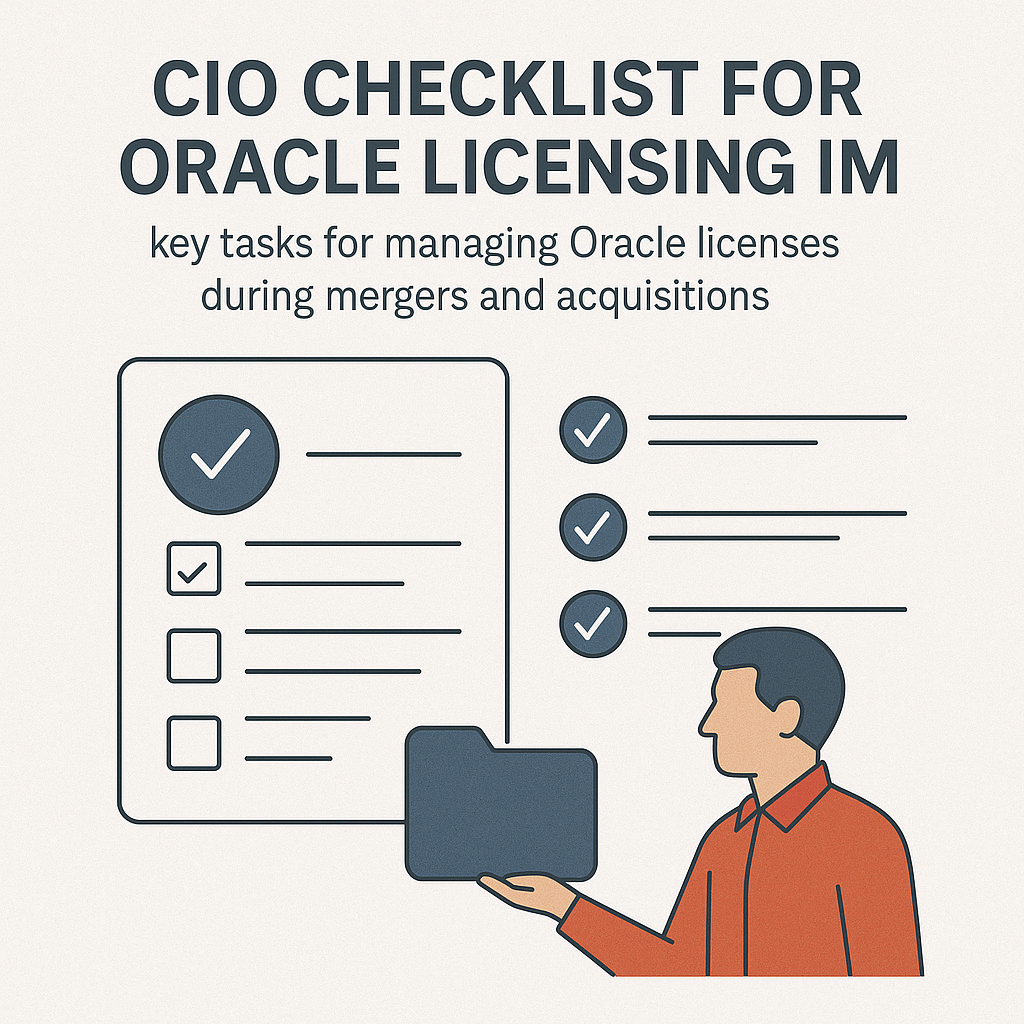
CIO Checklist for Oracle Licensing in M&A
A merger or acquisition can create significant Oracle licensing challenges, so CIOs must approach these events with a clear plan. This article provides a step-by-step Oracle licensing due diligence checklist for before, during, and after an M&A deal.
By inventorying licenses, reviewing contracts, negotiating with Oracle, and monitoring compliance post-merger, enterprise leaders can avoid costly surprises and ensure a smooth integration.
Pre-Merger: Inventory and Contract Review
- Inventory All Oracle Software: Before the merger closes, inventory all Oracle products in use at both companies. Document every deployment (product, version, platform, and usage metrics) to establish what licenses exist and what will be needed in the combined entity.
- Analyze Oracle Contracts: Gather all Oracle licensing contracts from both organizations (license agreements, ordering documents, ULAs, support contracts, etc.). Review them for clauses on assignment or change of control, and note which entities/locations are covered. This will highlight any restrictions or approvals you’ll need from Oracle as part of the merger.
Pre-Merger: Identify Gaps and Plan Costs
- Identify License Gaps and Overlaps: Compare the combined usage to current entitlements to identify any compliance gaps or overlaps. Determine if the merged company would be under-licensed for any Oracle product, or if there are redundant licenses that could be optimized.
- Assess Cost Impact: Estimate the cost to close any licensing gaps. If the combined entity requires additional Oracle licenses (or an expanded ULA), calculate the associated expense. Factor these costs into deal negotiations – for example, adjusting the purchase price or having the seller remediate license shortfalls before closing.
During the Deal: Engage Oracle and Negotiate
- Notify Oracle Strategically: If your contract requires notifying Oracle of the merger, plan the timing and messaging carefully (usually around closing). Coordinate with legal to draft a concise notice to Oracle regarding the change. Explain that you intend to remain compliant and will work with Oracle on any necessary contract updates, but avoid volunteering details about internal license issues.
- Negotiate License Transfers and Updates: Collaborate with Oracle to execute any necessary license transfers or contract amendments. Aim to carry over favorable terms from the acquired company and obtain Oracle’s written consent for any entity changes or assignments. If Oracle offers a new enterprise agreement or ULA for the combined company, evaluate it critically instead of agreeing under pressure.
- Agree on Transition Terms: If a divestiture or integration requires one company to temporarily use the other’s Oracle licenses, establish a Transition Services Agreement. Get Oracle’s acknowledgment in writing for any interim shared-use period (e.g., allowing a spun-off unit to use the parent’s licenses for 60 days post-separation).
Post-Merger: Update and Integrate Licenses
- Finalize Contract Changes: Ensure that all Oracle contract changes resulting from the merger are signed and recorded. Update your internal license tracking to reflect any new combined agreements or license assignments that have been made. Communicate the updated license terms to IT teams so everyone knows what is (and isn’t) allowed post-merger.
- Eliminate Redundancies: Optimize the merged Oracle license portfolio to reduce costs and improve efficiency. Decide whether to consolidate contracts or keep them separate for now. Decommission duplicate Oracle systems to free up licenses (for example, if both companies ran similar Oracle applications, retire one to reduce license needs). Be aware that consolidating contracts may affect discounts or support fees, so weigh the benefits carefully before making any changes.
- Integrate Systems with Compliance in Mind: As you integrate IT environments, do it in phases and verify licensing at each step. If you migrate an acquired system to an Oracle platform of the parent company (or vice versa), confirm that you have sufficient licenses for the additional usage. Avoid a “big bang” integration that could inadvertently exceed your Oracle entitlements.
Post-Merger: Ongoing Compliance Management
- Monitor Usage Continuously: After the merger, closely track Oracle software usage to ensure it remains within licensed limits. Regularly audit your Oracle deployments (including user counts, processor counts, etc.) to identify any compliance drift early.
- Educate Your Team: Inform IT and procurement teams about the post-merger Oracle licensing rules. Ensure everyone knows they must confirm license coverage before deploying Oracle products in new parts of the business. This prevents well-intentioned staff from accidentally violating license terms.
- Stay Audit-Ready: Maintain a comprehensive archive of Oracle licenses, contracts, and all correspondence with Oracle regarding the merger. Given Oracle’s tendency to audit after Mergers and Acquisitions, being organized will pay off. If Oracle initiates an audit, you’ll be ready to demonstrate the steps you took to remain compliant. Consider an internal “mock audit” a few months post-merger to double-check everything.
Recommendations
- Start Early: Begin Oracle license due diligence as soon as an M&A deal is on the horizon. Early action can uncover issues while there’s time to address them.
- Leverage Experts: Use Oracle licensing experts (internal or external) to guide your M&A licensing strategy. Their knowledge helps you avoid pitfalls and negotiate better terms.
- Document Everything: Get any Oracle approvals, transfer agreements, or special conditions in writing. Clear documentation is vital if questions or audits arise later.
- Budget for Licenses: Include Oracle license true-up or purchase costs in your M&A financial plan. It’s better to account for these expenses upfront than be caught off guard after the merger.
- Stay Vigilant Post-Merger: Even after contracts are updated, maintain discipline in tracking Oracle usage. A merger isn’t a one-time event for licensing – it requires ongoing oversight to ensure compliance.
Read about our Oracle Advisory Services.
